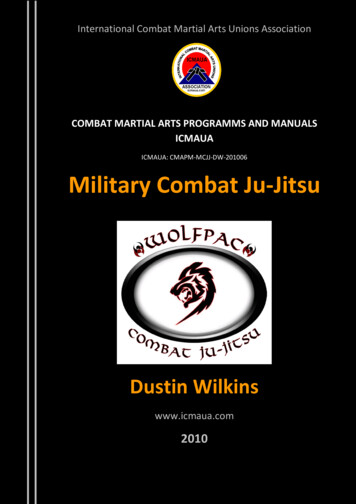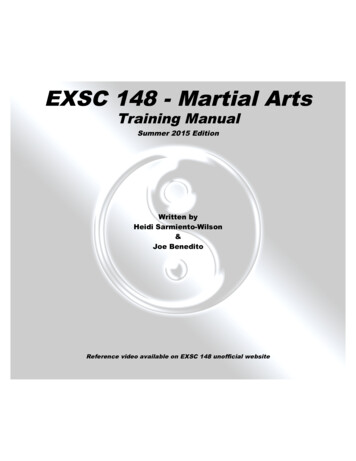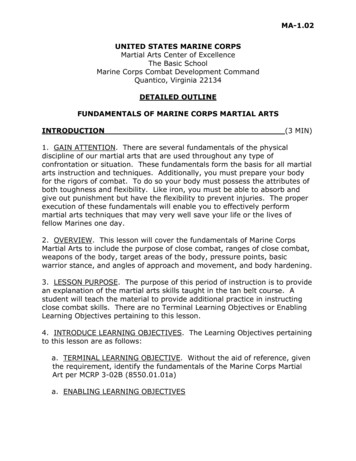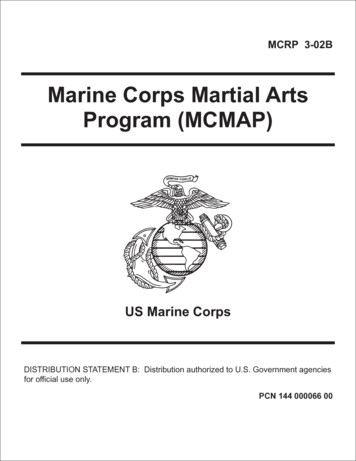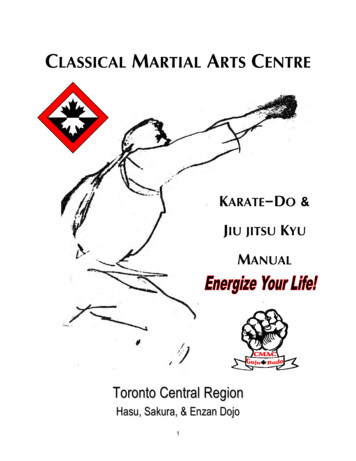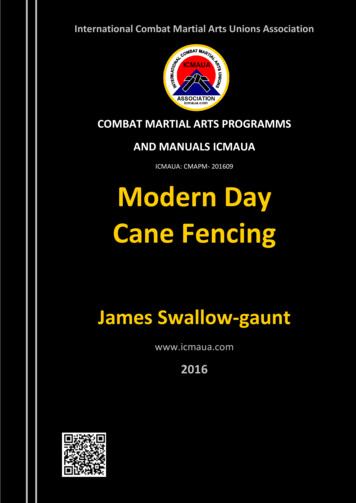
Transcription
James Swallow-Gaunt (2016): Modern Day cane Fencing. -Combat Martial Arts programms and manualsICMAUA, V.009., www.icmaua.com: 59 p.International Combat Martial Arts Unions AssociationCOMBAT MARTIAL ARTS PROGRAMMSAND MANUALS ICMAUAICMAUA: CMAPM- 201609Modern DayCane FencingJames Swallow-gauntwww.icmaua.com20161
James Swallow-Gaunt (2016): Modern Day cane Fencing. -Combat Martial Arts programms and manualsICMAUA, V.009., www.icmaua.com: 59 p.Combat Martial Arts programms and manuals ICMAUA publishes original programs andmanuals of Martial Arts styles, organizations and schools: trainings, belts (Kyu, Dan)requirements and exams, education and philosophy.Combat Martial Arts programms and manuals ICMAUA will be published after receiving ofmaterials from authors - members of the ICMAUACombat Martial Arts programms and manuals ICMAUA is published in a PDF format and isplaced in free access in the Library of Combat Martial Arts manuals and programms ICMAUA(www.icmaua.com).Combat Martial Arts programms and manuals ICMAUA publishes original papers "as iswritten by author", without any changes (also grammatical or stylistic) in the basic text.Changes in design are possible.Combat Martial Arts programms and manuals ICMAUA is distributed to members fromthe countries: Afghanistan, Algeria, Angola, Argentina, Australia, Austria, Azerbaijan,Bahrain, Bangladesh, Belarus, Belgium, Bosnia & Herzegovina, Brazil, Bulgaria, Cameroon,Canada, Chile, China, Costa Rica, Croatia, Denmark, Egypt, France, Finland, Germany,Georgia, Ghana, Greece, Guam, Guyana, Haiti, Hungary, India, Indonesia, Iran, Iraq, Ireland,Israel, Italy, Jamaica, Japan, Kazakhstan, Kuwait, Latvia, Luxembourg, Malaysia, Maldives,Malta, Mauritius, Mexico, Montenegro, Morocco, Nepal, Netherlands, New Zealand,Nigeria, North Korea, Norway, Pakistan, Peru, Philippines, Poland, Portugal, Puerto Rico,Romania, Russia, Saint Lucia, Saudi Arabia, Scotland, Serbia and Montenegro, Sierra Leone,Singapore, Slovenia, South Africa, South Korea, Spain, Sri Lanka, Sudan, Sweden,Switzerland, Syria, Tajikistan, Thailand, Trinidad and Tobago, Tunisia, Turkey, Uganda,Ukraine, United Arab Emirates, United Kingdom, United States of America, Uruguay,Uzbekistan, Venezuela, Yemen, Yugoslavia.DisclaimerThe full responsibility for the published articles belongs to the authors.The publisher, editors of the Combat Martial Arts programms and manuals ICMAUA andICMAUA disclaim responsibility for any liability, injuries, or damages.Address for correspondence:info@icmaua.com2
James Swallow-Gaunt (2016): Modern Day cane Fencing. -Combat Martial Arts programms and manualsICMAUA, V.009., www.icmaua.com: 59 p.Modern Day cane fencing Syllabus offers aformal method of training in the oldVictorian Martial art . It teaches the oldGentlemans and Ladies singlestick andcane fencing system.It stays true to the original etiquette andrules of one of the oldest western MartialArts.It has been written by a qualified andaccredited self defence Instructor, MartialArts Instructor and British Fencingregistered coach/Modern Daycane FencingGSDO UK Self defenseWritten by James Swallowgaunt 19/08/2016British Martial Arts & Boxing Association,3
James Swallow-Gaunt (2016): Modern Day cane Fencing. -Combat Martial Arts programms and manualsICMAUA, V.009., www.icmaua.com: 59 p.Modern cane fencingOverview & SummaryOverviewThe Modern cane fencing has been developed by BMABA committee member, Formersoldier, qualified & accredited self defence instructor, Martial artist, close quarter combatinstructor and Registered British Fencing association coach and UK Grand Master J SwallowGaunt.The system has taken the very effective Sabre Fencing and singlestick close quarter combattechniques taught to the Gentleman & Ladies since the Victorian era. The fencing elementsare still used today by Olympic fencing athletes, cane fencing was taught in the originalmixed martial art Bartitsu. Bartitsu was introduced by E.W Barton-Wright. He taughtsinglestick and cane fencing in his combat laboraty in the late 1800s.This modern system stays true to the original etiquette of this gentlemans and ladies martial.It has been developed in alignment with the nationally recognised grading for Britishfencings Sabre fencing and is a great Introductionand crss over to this Olympic sport as wellas being a highly effective self defence system in its own right.Adapted this system is a great Incusive self defence system that can be taught to studentswith disabilities or wheel chair users.The system teaches praticial techniques that do not require years and years worth of martialarts experince and uses the science of the human physiology to deploy effective breakawaytechniques.It also teaches students to control their emotions and fear to remain in a effective emotionalresponse to carry out the techniques to defend themselves.All of the understanding and defensive techniques make an extremely effective fightingsystem.As well as teching the techniques the system has been designed to give all students theunderstanding of the use of reasonable force and the UK laws regarding the use ofreasonable force in self defence.The system teaches situational awareness, avoidance, assertiveness and conflictmanagement skills. All the techniques are defensive techniques and are not taught are anaggressive fighting technique.4
James Swallow-Gaunt (2016): Modern Day cane Fencing. -Combat Martial Arts programms and manualsICMAUA, V.009., www.icmaua.com: 59 p.Assessment Of Fair Rights & RequirementIn this section you should aim to answer all of the below listed questions in context to yoursyllabus / style and it’s instruction. Note that although the answers given will be used whenassessing your syllabus or style this page and it’s contents WILL NOT be published in our show casein the interests of protecting your style/syllabus. (Please remove this paragraph of text prior toanswering the below questions)Gradings & Internal Progression1.) Does your style or syllabus incorporate a grading structure or system?Yes we offer a grading system we feel this is the best way to assess a students progress and gives thestudent a great sense of achievement and confidence. Therefore ensuring they stay with the systemand help them build on their skills1. a) IF YES, how do you propose to ensure gradings are assessed in a fair manor which reflects only theindividuals participation and conduct? Please also consider and mention how gradings will be assessed if youare not grading the students, this relates to the style or syllabuses progression.GradingOur grading is will be licensed and part of the BMABA grading integrity scheme, all certifications are orderedfrom the BMABA by the UK lead Instructor. Each grade has a syllabus to be taught in the clubs.Our Grades are shown as coloured arm flashes instead of belts to suit the imagine of the styleTo ensure that the GSDO system maintains its quality are grading are subject to IQA audits and therefore alldocumentation recorded has the correct information.All Grading sessions are required to be pre planned and documentation is required to be sent to the UK HeadInstructor a minimum of 72 hrs prior to the grading.Club head instructors can grade up to Black flashstrd1 Dan to 3 Dan need to be assessed by UK lead Instructors4 Th Dan on wards are required to be graded by the founder of the system.Grade Kyu5
James Swallow-Gaunt (2016): Modern Day cane Fencing. -Combat Martial Arts programms and manualsICMAUA, V.009., www.icmaua.com: 59 p.White flashNovice, beginner.stWhite flashred tag 1 KyuInitial Grading within 4 weeks, when members become associated to GSDO UK and The BMABAGrading requirementsStudents most show they can resite the combat Lab (DOJO) rules on safety, The Gentlemans and Ladies Oath.They must have shown they have Respect for the main Instructor and others instructors in club( this coversInstructors from other clubs).The Student must be able to demonstrate a knowledge of what safety equipment is worn in training. Theyshow they are able to use the correct personal protective clothing Masks, Pads and gloves.Students must achieve this Grading although there is no cost for this grading it is essential to be able to achievethe following grades.They cannot move through the grading s until they have achieved this.The this grading and is awarded when the instructor Decides they can; Students must resite the combat Labs rules and safety rules of cane fencing Students must resite the Gentlemans and Ladies OathDemonstrate: (with coach or partner) The Grip The Salute The On guard - Guard of Tierce & Quarte over leading leg and rear leg. Steps Forward and Backward Cuts to Head, Flank and Chest Direct Attack with lunge to Head, Flank and Chest Parries of Tierce, Quarte and Quinte with a Direct Riposte over leading leg and rear leg.Describe: How to use your Sabre safely How to fence safely The Target Area An Attack and a Parry with Riposte Fencing Etiquette6
James Swallow-Gaunt (2016): Modern Day cane Fencing. -Combat Martial Arts programms and manualsICMAUA, V.009., www.icmaua.com: 59 p.ndYellow flash 2 KyuThis grading can only be taken after 18 weeksThis assessed grading and the students show they have a basic understanding of how to keep a safe distance,the must be able to demonstrate they understand they personal space and have a good grasp of situationalawareness.The student must be able to demonstrate that fighting is the last avenue to be taken if they cant resolve theattack through being aware, avoidance and being assertive using verbal commands, taking the opportunity toavoid the conflict, keeping distance and controlling movement.Demonstrate: (with coach or partner).While following your partner's steps forward and backward: Maintain correct lunging distance Maintain correct distances and Cut to Head, Flank and Chest without a lunge Maintain correct distance and each time your partner pauses Cut to Head, Flank and Chestwith a full lunge Each time your partner Attacks with a lunge to Head, Flank or Chest, Parry Tierce, Quarte orQuinte with a Direct RipostFrom a stationary position: Direct and Indirect hits with the point Successive Cuts to Cheek, Head, Flank and Chest using various combinations Indirect Cuts to Head, Flank and ChestDescribe:1. Courteous and respectful behaviour and fencers 'Pledge of Honour" (cf. t.114, t.116, t.120)The awarding of the belt must be done at the grading ceremony with the club present to show respect for theranking.rdRed Flash 3 KyuStudents can only grade for red after 24 weeks.Student must be able to demonstrate they have a good grasp of the law regarding self defence, the use ofreasonable and proportionate force.They must be able to show they can control space and distance from an opponent. They must be able showthey can defend themselves from direct strikes whilst showing they understand a proportionate andreasonable response.Demonstrate: (with coach or partner)-While following your partner's steps forward and backward:7
James Swallow-Gaunt (2016): Modern Day cane Fencing. -Combat Martial Arts programms and manualsICMAUA, V.009., www.icmaua.com: 59 p. Maintain correct distance and make successive Cuts to Cheek, Head, Flank and Chest usingvarious combinations, without a lunge Maintain correct distance and each time your partner pauses, Attack with Direct andIndirect Cuts to Head, Flank and Chest, with a lungeFrom a stationary position:1. Cuts to Arm2. Stop Cut followed by a Parry of Tierce, Quarte or Quinte with a Direct Riposte3. Indirect Riposte following Parries of Tierce, Quarte and Quinte4. Parries of Tierce, Quarte and Quinte with a Direct first Counter-riposte5. Attacks to Head, Flank and Chest with step-lunge and Balestra-lungeDescribe: 'Priority of Attack" Indirect Actions - give three examples Duties of President and Judges Voting system of Jury and Responses of JudgesThe awarding of the flash must be done at the grading ceremony with the club present to show respect for therankingthGreen flash 4 KyuThe student can grade for Green after 36 weeksThe student must be able to demonstrate they understand when throws can be effective orwhen breaking the engagement is more suitable. They must be able to demonstrate a effective use of distanceand control space and be able to demonstrate an understanding of balance and counter balance to execute aParry riposte .Demonstrate: (with coach or partner)-While following your partner's steps forward and backward: Maintain correct distance and when your partner pauses, Attack to arm with a lunge Maintain correct distance and as your partner makes a Balestra preparation and an Attackwith lunge, Cut to arm with a step back and Parry-Riposte Maintain correct distance and as your partner pauses, Attack with a step-lunge and if yourpartner parries with a Riposte, Parry with a First Counter-riposteFrom a stationary position: Direct and Indirect Attacks with Balestra step 6) Parries of Prime and Seconde8
James Swallow-Gaunt (2016): Modern Day cane Fencing. -Combat Martial Arts programms and manualsICMAUA, V.009., www.icmaua.com: 59 p. Beats and Circular BeatsDescribe: Corps-a-Corps Turning o Hard hitting and dangerous fencing Simultaneous AttacksStudents must be able to demonstrate these techniques from staionary and movingBlue flash-5th KyuStudents can only grade for blue after 30 weeksBlue belt must be able to show the can use a preemptive strike to either defuse the situation as a finisher or tocorrect distance and control of space. They must be able to demonstrate they can carry out effectivetechniques to stop an attack before it becomes an effective one.They must be able to demonstrate they are able to read the signs of an attackThey must also be able to demonstrate a breakaway technique if the preemptive strike cannot not be used.They must be able to react quickly and create distance and control spaceDemonstrate: (with coach or partner)-While following your partner's steps forward and backward:1. Maintain correct distance and choose the moment to step forward with a direct feint deceive yourpartner's Parry and continue the Attack with a lunge2. Choose the moment to begin Balestra Steps Preparation and as your partner moves away and Parries,Attack into the opening line with a lunge3. Maintain correct distance and step forward as a Preparation Attack and: o If your partner Parries,Attack into the opening line with a lunge o If your partner Attacks, Parry-Riposte4. Maintain correct distance and make a Compound Attack to your partner's arm with a lungeFrom a Stationary Position:1) Circular Cuts to arm and chest2) Compound Ripostes and Counter-ripostes3) Ripostes and Counter-ripostes with Balestra Steps and lungeDescribe: Second-intention actions Simple and compound actions Use of preparations9
James Swallow-Gaunt (2016): Modern Day cane Fencing. -Combat Martial Arts programms and manualsICMAUA, V.009., www.icmaua.com: 59 p.The awarding of the belt must be done at the grading ceremony with the club present to show respect for therankingthBrown flash 6 KyuStudents can grade for Brown Belt after 40 weeksDemonstrate: (with coach or partner)-While following your partner's steps forward and backward: Maintain connect distance and choose the moment to make a step forward preparationand: o If your partner's arm straightens with the point in line, Beat Attack Direct with lunge o If yourpartner fails to react, Attack with a Compound action with lunge Choose the moment to Attack with a lunge to draw your partner's Parry-riposte and parrywith a forward Recovery and counter- riposte with lunge Maintain distance and when your partner Attacks, Parry and make a Compound RiposteFrom a stationary position:1. Compound Attacks with the point2. Indirect and Compound Derobements with the point3. Successive ParriesDescribe: Use of "line" and Derobements Counter-offensive actions Fencing time: single and multi-time actions What is meant by "taking the initiative" and why is this important in a fight?The awarding of the belt must be done at the grading ceremony with the club present to show respect for therankingthPurple flash 7 Kyustudents can grade after 52 weeksDemonstrate: (with coach or partner)-While following your partner's steps forward and backward: Maintain step-lunge distance with your arm straight and point in line; as your partner attempts tostep forward to beat the blade and parry, lunge and make a compound attack with the point With the point in line, move away from your partner's Balestra Steps preparation and deceive theattempt to beat and parry with a compound Derobement Maintain distance and as your partner begins a Balestra Steps Preparation, beat attack to headwith a lunge using a circular beat Maintain distance and when your partner makes a compound attack with a step lunge, defend10
James Swallow-Gaunt (2016): Modern Day cane Fencing. -Combat Martial Arts programms and manualsICMAUA, V.009., www.icmaua.com: 59 p.using successive parries with direct riposteFrom a stationary position:1. Remise, Reprise, Redoublement2. Compound attacks beginning with point in line and ending with a cut3. Circular ParriesDescribe: 'Open Eyes' actions Feint Parries False preparationsThey must demonstrate all techniques from moving and static drill then the instructor will choose 3 attacks tobe defended in full scenario.thafter 65 weeks 8 KyuDemonstrate: (with coach or partner)-While following your partner's steps forward and backward:1. Maintain step-lunge distance and choose the moment to make a compound Attack using a Balestralunge or Balestra Steps lunge depending on your partner's reaction2. Maintain distance and as your partner steps forward with a feint either:o Move away and defend using successful parries, oro Counter-attack with lunge using a circular beat3. Step forward to draw a stop cut to arm and parry-riposte with a lunge From a sFrom Stationary position: With the sabre held in a low position, parry into Tierce, Quarte or Quinte when your partner attacksand make an indirect riposte Beat cut to arm with a step, beat cut to cheek with a lunge and beat cut to head with a Balestra Lungeand with increasing speed Stop cut, redouble-parry-riposte combinationsDescribe:1. Compound and double preparations2. Your understanding of distance, timing and speed in fencing3. Prise de fer actions11
James Swallow-Gaunt (2016): Modern Day cane Fencing. -Combat Martial Arts programms and manualsICMAUA, V.009., www.icmaua.com: 59 p.The Instructor will pick 8 attacks from a single attacker the student most show they can defend themselveseffectively.thPurple and red tag after 75 weeks 9 KyuDemonstrate: (with coach or partner)-While following your partner's steps forward and backward: Choose the moment to make a step forward preparation ando Parry-riposte if your partner attackso Make a compound attack with a lunge if your partner parrieso Make a compound attack with Balestra Steps Lunge if your partner moves away Defend against your partner's attack using parries of Prime and Seconde and Quinte Attack with a step-lunge ando if your partner parries and ripostes, then parry and hit with a first counterriposte while on lunge o ifyour partner parries and ripostes with a step back, then parry with a forward recovery and hit with acompound riposte with lungeo If your partner moves away, then hit with a compound reprise with forward recovery and Balestra StepslungeFrom a stationary position:1. Set up a simultaneous attack situation with your partner and occasionally make a second-intentionpreparation with a parry-riposte2. From a step-lunge distance, step forward ando Attack to head with an explosive lunge if your partner does not moveo Cut to head with a step back if your partner steps forwardo Attack to head with Balestra lunge if your partner steps backDemonstrate your ability to: Fence your partner for 5 hits and explain how all the hits were scored Preside a fight for 5 hits3. Give your partner a short "warm-up" lesson with mobility, involving direct and indirect attacks, singleparries with direct ripostes and counter-riposteThe Instructor will pick 8 attacks from a pair off attacker the student most show they can defend themselveseffectively.Black BeltAs a Purple belt black stripe of the system you need to b able to demonstrate a full knowledge of thetechniques shown and learn t.12
James Swallow-Gaunt (2016): Modern Day cane Fencing. -Combat Martial Arts programms and manualsICMAUA, V.009., www.icmaua.com: 59 p.You also need to demonstrate an excellent knowledge of self defence and the use of reasonable andproportionate force and be able to teach this to students.The student becomes the teacher they must been able to assist in the teaching all the techniques from thesyllabus.They need to be able to demonstrate they can assist in the teaching a lesson to a class and show they canassess the students.The lead instructor will give the Black belt candidate a session to teach they will briefed on the lesson they willbe instructing they must prepare the session plan and cover a warm up, main session and cover health andsafety and look at different learning styles.They will also be required to plan and deliver a grading session and give feedback to students.They must be able to demonstrate they can maintain and carry out the required administration to successfulclub.MasterBy invitation onlyTo achieve this grade the candiate must show then can teach all of the techniques of the system. The must beable to show they can plan and teach a full grading topic.They must show they can teach and coach a full syallbus, they must demonstrate knowledge andunderstanding to run a full grading system.The candiates will be given a belt to grade and they must carry out the necessay planning for the full gradingincluding drills.They must demonstrate they can run a program with out assitance.Grand MasterBy invitation only.Candiates must show and demonstrate they can manage and run their own club.Appeals Policy and Procedure for grading13
James Swallow-Gaunt (2016): Modern Day cane Fencing. -Combat Martial Arts programms and manualsICMAUA, V.009., www.icmaua.com: 59 p.‘Competent’ or ‘Pass’ cannot be contested. ‘Not yet competent’ or ‘fail’ can be contested. Sources ofdisagreement may include: the interpretation of the candidate’s behaviour in relation to values/good practice, claimthe assessor may miss some working practice which the candidate believesto competence in a unit, the assessor may require more evidence that assessment criteria is being met than thecandidate believes necessary.Where candidates believe that they have grounds to appeal against the judgment ofthey should:supports theiranassessor toadvisethe assessor of this and ask the assessor to consider taking appropriate actionrectify the situation, If this is unsuccessful the candidate should refer the matter to the IQA for consideration, If the candidate is still not satisfied with the process he/she shouldCentre coordinator to implement a formal appeal.contacttheThe Appeal Panel: is independent of instructors, will be strictly neutral, will make use of evidence gathered during assessment, will be comprised of the Quality Assurance Coordinator and other appropriateassessors or Internal Quality Assurers, depending upon the nature of the appeal.Candidates can ask for support(from mentors and others) to assemble their evidence for an appeal against a‘not yet competent’ or ‘fail’ decision.The appeal should be registered with the Centre Qualifications Coordinator within 21 days of the assessmentdecision being given to the candidate. The Coordinator will acknowledge receipt within 5 working days.(Unlessout of the office, then immediately on return.)The Appeals Panel will meet within 20 working days of the appeal being received by the Centre Coordinator toconsider the appeal. If the Appeals Panel require further i information or evidence the Centre Coordinator willgather this on behalf of the Panel.The Panel’s decision will be given in writing to all those involved in the Appeal.If the Appeals Panel decision is not acceptable the person concerned can then appeal to the AwardingOrganisation whose decision is final. Addresses are available from Head office 54 ward street, Penistone,Sheffield S36 6EPAll contacts regarding an appeal will be treated as urgent and confidential.All records relating to appeals will be kept by the Centre for a minimum of three years.14
James Swallow-Gaunt (2016): Modern Day cane Fencing. -Combat Martial Arts programms and manualsICMAUA, V.009., www.icmaua.com: 59 p.1. b) IF NO, could you please explain why your style or syllabus does not include an assessment or gradingsystem and how you plan to (if at all) reward student’s progress and recognise progression?Please delete this text and type your answer here.2.) What age range, gender and identify to you associate your style or syllabus with?Age Range: 8 years onwards due to the nature of the syallbus however we are part of the Martial Artist Against Bullyingprogram so we will be working with children 6 years teaching personal safety not the rimary Market: Young people, vunerable adults, and any students that need safe breakaway trainingYour Style or Syllabus Identity & Roots1.) Please identify and explain the origin of your syllabus or style. Please also detail any styles ordisciplines that it consists of and how it’s incorporated.The Modern cane fencing has been developed by Former soldier, qualified & accredited selfdefence instructor, Martial artist, close quarter combat instructor and Registered BritishFencing association coach and UK Grand Master J Swallow-Gaunt.The system has taken the very effective Sabre Fencing and singlestick close quarter combattechniques taught to the Gentleman & Ladies since the Victorian era. The fencing elementsare still used today by Olympic fencing athletes, cane fencing was taught in the originalmixed martial art Bartitsu. Bartitsu was introduced by E.W Barton-Wright. He taughtsinglestick and cane fencing in his combat laboraty in the late 1800s.This modern system stays true to the original etiquette of this gentlemans and ladies martial.It has been developed in alignment with the nationally recognised grading for Britishfencings Sabre fencing and is a great Introductionand crss over to this Olympic sport as wellas being a highly effective self defence system in its own right.Adapted this system is a great Incusive self defence system that can be taught to studentswith disabilities or wheel chair users.The system teaches praticial techniques that do not require years and years worth of martialarts experince and uses the science of the human physiology to deploy effective breakawaytechniques.It also teaches students to control their emotions and fear to remain in a effective emotionalresponse to carry out the techniques to defend themselves.All of the understanding and defensive techniques make an extremely effective fightingsystem.15
James Swallow-Gaunt (2016): Modern Day cane Fencing. -Combat Martial Arts programms and manualsICMAUA, V.009., www.icmaua.com: 59 p.As well as teching the techniques the system has been designed to give all students theunderstanding of the use of reasonable force and the UK laws regarding the use ofreasonable force in self defence.The system teaches situational awareness, avoidance, assertiveness and conflictmanagement skills. All the techniques are defensive techniques and are not taught are anaggressive fighting technique.2.) Please describe your personal and professional journey through all martial arts practices listedwithin this syllabus explaining how you discovered the styles, why they were effective for you &why / how they’ve been included in your teachings.As a childI was not the popular kid and being in a boarding school because my father was inthe forces i struggled to find acceptance.At a young age i started doing Karate but found this was something that relied on kickingand punching and found it hard and complicated. After a few years i started aikido which ifound really exciting and easy to use due to the fact i was using the opponenants own bodyweight and balance against them. I study the art of Aikido late into me teens before i Joinedthe Armed Forces. As a soldier my first experince of unarmed combat was when i wasselected into display team. I thrieved in this envorniment and quickly developed new skills.Before my first deployement to Northern Ireland my Aikido experience was re ignited as welearnt new breakaway techniques as part of the NITAT training, these techniques wher putinto practice during the roits in Belfast in 1993 when when someone attempted to snatchmy rifle off me. Again we i applied for the elite special observation battery we again drilled inunarmed combat with the physical training Instructors.After leaving the Army i held a few jobs up to the last 5 years where i got involved withtraining and coaching sport with school kids. I was asked to get involved in delivering fencingwhich i did and set up a fencing club I now work directly with British Fencing as an accreditedcoach and have taught foil fencing to over 10000 children in South Yorkshire. Because of myexperience in the forces i had a number of parents asking me to run a fitness bootcampwhere i incorporate self defence into the sessions i found that the response was huge.I then invested alot of time ensuring i had a great undersatnding in reasonable force i tookand number of nationally recognised qualifications to ensure my knowledge was up to date.I now teach breakaway to a number of private clients and i also teach military unarmed closequarter combat to private security contractors.Since school I have been a keen fencers and I have been involved in developing stratagies todevelop fencing.16
James Swallow-Gaunt (2016): Modern Day cane Fencing. -Co
James Swallow-Gaunt (2016): Modern Day cane Fencing. -Combat Martial Arts programms and manuals ICMAUA, V.009., www.icmaua.com: 59 p. 2 Combat Martial Arts programms and manuals ICMAUA publishes original programs and manuals of Martial Arts style
